FoodShooter
Member
I had a few minutes to spare today and finally got around to do a little lens testing that I've been meaning to do for a while. Admittedly, this is far from a scientific or controlled test, it was meant to satisfy my curiosity more than anything else and ended up leaving me more confused than when I started!
By way of background, I shoot with an older medium format back attached to a Cambo Ultima 23 view camera. As I mentioned in another thread, at the time of purchasing my digital system in 2006, my budget did not include additional funds for new lenses, so I kept moving ahead using the view camera lenses I'd acquired in my film days. 100mm 5.6 Rodenstock, 135mm 5.6 Fujinon, 90mm f8 Schneider Super Angulon. Sold off the 210 which had been my 'normal' in 4X5 as it was simply too long for the kind of work that I do.
My 'traditional' film lenses have always provided the kinds of images that I expected. Good color/contrast/sharpness, etc. without any noticeable flaws as seen both on the monitors that I use as well as in the finished printed (off-set) finished pieces.
Today, I decided to do a little experiment to see how my Fujinon 135 might stack up against a different lens that was in the studio. Not sure what (if anything) this means, but I didn't anticipate the results and thought some of you may find this of some interest.
Both test images were captured with a Leaf Valeo 22 MP (vintage back) Note that in the test images, the plate was moved slightly in the time that it took me to change lenses as the client reached in after the shot to take his own image and he rotated the plate a bit....so they're not 'exact'.
back) Note that in the test images, the plate was moved slightly in the time that it took me to change lenses as the client reached in after the shot to take his own image and he rotated the plate a bit....so they're not 'exact'.
Now, on with the show...
Let me introduce you to the camera back:
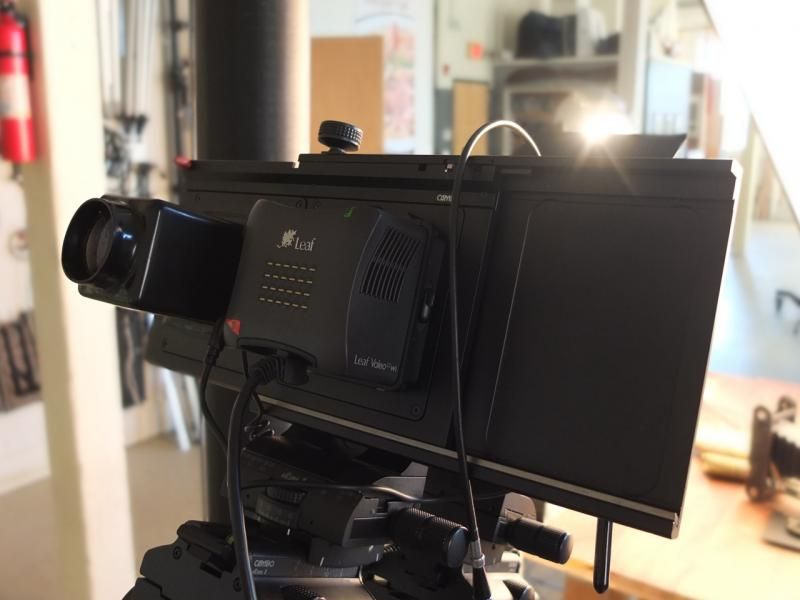
And now, the Fujinon 135:
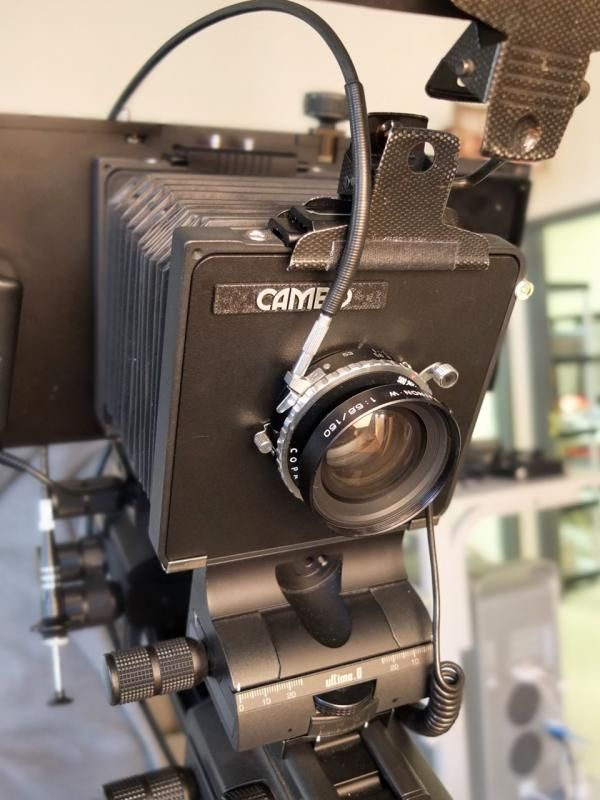
And the result:

Now, the image with the 'new' lens:

And the 'new' lens itself, first from the rear:
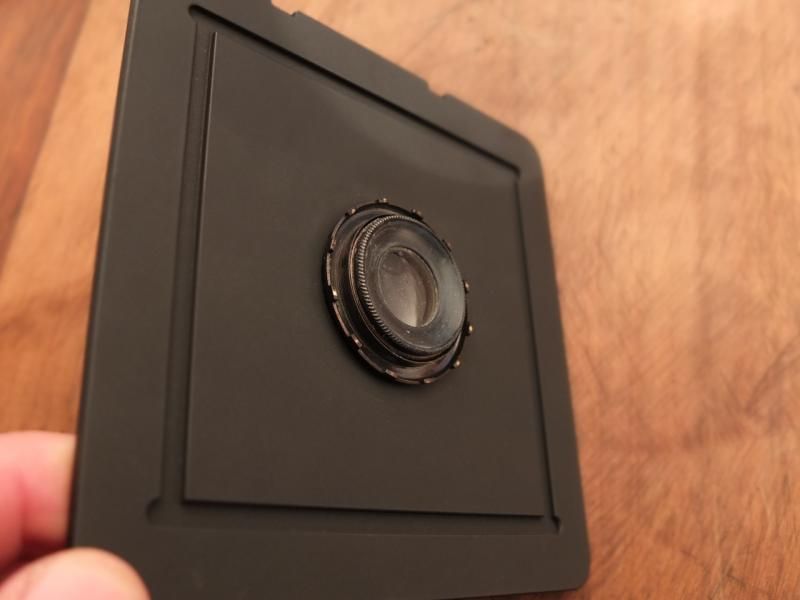
And now, from the front:
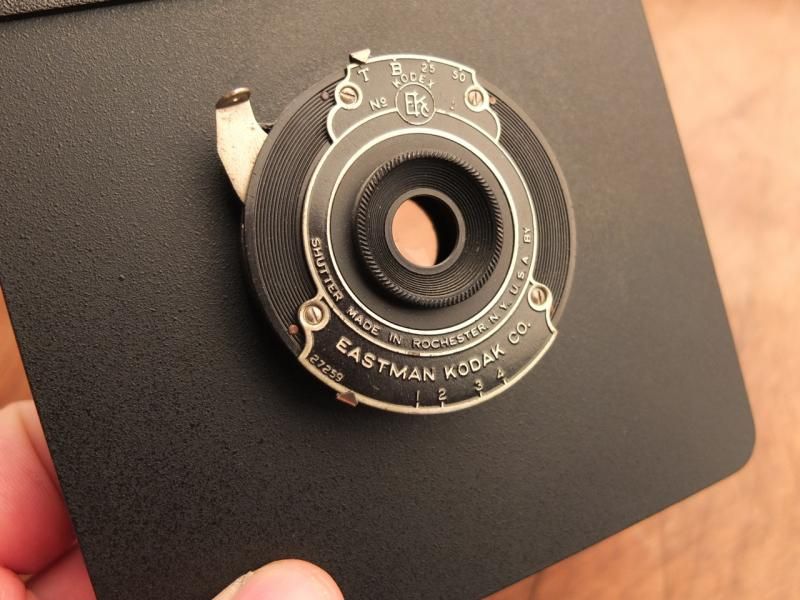
Here it is again:
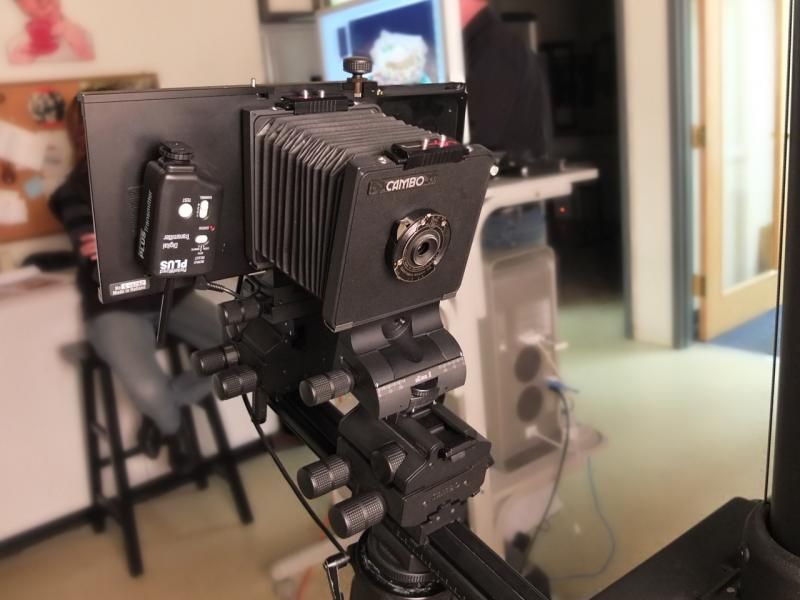
And lastly, from where it was sourced:

As best I can tell, this is a Kodak 'Autograph' camera (it has a small stylus for burnishing a message onto the negative through a trap door). THe latest patent date on the inside reads 1919. This camera has sat out in my studio for 25 + years collecting dust, not to mention all of the fry oil that circulates through the studio on any given day. It seems to be a simple single element lens and obviously is anything but sophisticated. I put the lens on 'B', killed the modeling lights and with the Fuji still connected to both the back and strobe used the Fujinon to fire the back and strobes, and then closed the Kodak.
I was half expecting some some quirky 'vintage' look (whatever that might be)...some color fringing maybe, or a little vignetting...certainly some edge softness? But nope...the image looked pretty good, especially considering that it was some 65 or so years behind the engineering/manufacturing curve of the Fujinon. I looked at both images at 100% and while the Fuji looked as I expected, the Kodak wasn't noticeably inferior and a further scan of the Kodak image didn't reveal any obvious shortcomings. My assistant said "Wow...that's a keeper"!
Both of these images are processed through the Leaf software with whatever the default sharpening is (which is our typical starting point before an image goes on to further editing.)
I dunno...maybe the Fuji is a dog...maybe the Kodak is a hidden jem, maybe I don't need new 'digital' lenses afterall...maybe I just need to spend more time in antique shops
By way of background, I shoot with an older medium format back attached to a Cambo Ultima 23 view camera. As I mentioned in another thread, at the time of purchasing my digital system in 2006, my budget did not include additional funds for new lenses, so I kept moving ahead using the view camera lenses I'd acquired in my film days. 100mm 5.6 Rodenstock, 135mm 5.6 Fujinon, 90mm f8 Schneider Super Angulon. Sold off the 210 which had been my 'normal' in 4X5 as it was simply too long for the kind of work that I do.
My 'traditional' film lenses have always provided the kinds of images that I expected. Good color/contrast/sharpness, etc. without any noticeable flaws as seen both on the monitors that I use as well as in the finished printed (off-set) finished pieces.
Today, I decided to do a little experiment to see how my Fujinon 135 might stack up against a different lens that was in the studio. Not sure what (if anything) this means, but I didn't anticipate the results and thought some of you may find this of some interest.
Both test images were captured with a Leaf Valeo 22 MP (vintage
Now, on with the show...
Let me introduce you to the camera back:

And now, the Fujinon 135:

And the result:

Now, the image with the 'new' lens:

And the 'new' lens itself, first from the rear:

And now, from the front:

Here it is again:

And lastly, from where it was sourced:

As best I can tell, this is a Kodak 'Autograph' camera (it has a small stylus for burnishing a message onto the negative through a trap door). THe latest patent date on the inside reads 1919. This camera has sat out in my studio for 25 + years collecting dust, not to mention all of the fry oil that circulates through the studio on any given day. It seems to be a simple single element lens and obviously is anything but sophisticated. I put the lens on 'B', killed the modeling lights and with the Fuji still connected to both the back and strobe used the Fujinon to fire the back and strobes, and then closed the Kodak.
I was half expecting some some quirky 'vintage' look (whatever that might be)...some color fringing maybe, or a little vignetting...certainly some edge softness? But nope...the image looked pretty good, especially considering that it was some 65 or so years behind the engineering/manufacturing curve of the Fujinon. I looked at both images at 100% and while the Fuji looked as I expected, the Kodak wasn't noticeably inferior and a further scan of the Kodak image didn't reveal any obvious shortcomings. My assistant said "Wow...that's a keeper"!
Both of these images are processed through the Leaf software with whatever the default sharpening is (which is our typical starting point before an image goes on to further editing.)
I dunno...maybe the Fuji is a dog...maybe the Kodak is a hidden jem, maybe I don't need new 'digital' lenses afterall...maybe I just need to spend more time in antique shops
Last edited:
